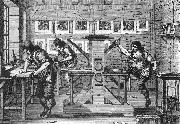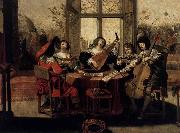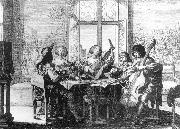|
Here are all the paintings of BOSSE, Abraham 01
| ID |
Painting |
Oil Pantings, Sorted from A to Z |
Painting Description |
| 5270 |
 |
A Printer s Workshop |
c. 1642
Etching
Museum het Rembrandthuis, Amsterdam |
| 96035 |
 |
Hearing |
circa 1635(1635)
Medium oil on canvas
cyf |
| 5269 |
 |
Musical Society |
c. 1635
Copper engraving
Biblioth??que Nationale, Paris |
|
|
| BOSSE, Abraham
|
| French Baroque Era Engraver, 1602-1676
Roughly 1600 etchings are attributed to him, with subjects including: daily life , religion, literature , history, fashion[8], technology, and science. Most of his output was illustrations for books, but many were also sold separately. His style grows from Dutch and Flemish art, but is given a strongly French flavour. Many of his images give fascinating and informative detail about middle and upper-class daily life in the period, although they must be treated with care as historical evidence. His combination of very carefully depicted grand interiors with relatively trivial domestic subjects was original and highly influential on French art, and also abroad ?? William Hogarth's engravings are, among other things, a parody of the style. Most of his images are perhaps best regarded as illustrations rather than art.
Watercolour of a ball by Abraham Bosse, a similar subject to many of his most famous etchingsHe was apprenticed in Paris about 1620 to the Antwerp-born engraver Melchior Tavernier (1564?C1641), who was also an important publisher. His first etchings date to 1622, and are influenced by Jacques Bellange. Following a meeting in Paris about 1630, he became a follower of Jacques Callot, whose technical innovations in etching he popularised in a famous and much translated Manual of Etching(1645), the first to be published. He took Callot's highly detailed small images to a larger size, and a wider range of subject matter.
Unlike Callot, his declared aim, in which he largely succeeded, was to make etchings look like engravings, to which end he sacrificed willingly the freedom of the etched line, whilst certainly exploiting to the full the speed of the technique. Like most etchers, he frequently used engraving on a plate in addition to etching, but produced no pure engravings.
|
|


